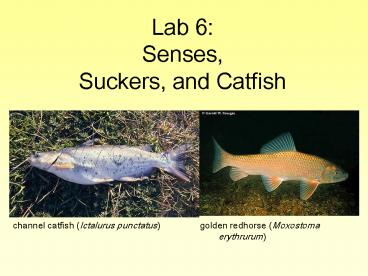Lab 6: Senses, Suckers, and Catfish PowerPoint PPT Presentation
1 / 29
Title: Lab 6: Senses, Suckers, and Catfish
1
Lab 6Senses, Suckers, and Catfish
channel catfish (Ictalurus punctatus)
golden redhorse (Moxostoma erythrurum)
2
Four main sensory systems in fish
- Chemoreception olfaction and taste
- Acoustico-lateralis hearing and lat. line
- Electroreception
- Photoreception/vision
3
Chemoreception -- olfaction
- Olfaction smell
- Nares
- Used for food detection, orientation, predator
avoidance
Nare function of american eel (Anguilla anguilla)
4
Nares of different fishes
- The of lamellae (folds) usually correlate with
the ability to smell - Range from 0 (seahorses) to 230 (porgy).
5
Chemoreception Examples
- Salmonid homing adults use nares to detect
chemical signature of native stream - Cyprinids, Catostomids use papillae on their lips
- Ictalurids use barbels, note the orientation of
the barbels - How do you test these senses.plug or block them!
6
Auditory Systems-- Acoustico-lateralis
- Inner ear and otoliths
- Swim bladder and Weberian apparatus
- Lateral Line
7
Inner Ear -- Otolith
- Otolith (hard earstone) held in a fluid sac,
saculus, 3x density - Hairs inside the sac detect otoliths movement,
fish moves otolith stays in place cause it is
more dense - Also balances the fish in three planes
8
Swimbladder and Weberian Apparatus
- Bony connection between swimbladder and inner
ear, - Dense water?less dense air causes swim bladder to
vibrate, the Weberian apparatus transmit
vibrations to the inner ear.
9
Lateral line distant touch
- Neuromast
Hair cells
10
Electroreception
- Widespread among fishes.except teleosts
- Freshwater examples gymnotid, electric
catfishes, African electricfishesthe mormyridae,
really cool! - Useful in finding food, especially in turbid
environments
11
Vision
- Most can see color, but more rods then cones
- Rods are much more precise, therefore used to
detect movement - Tapetum lucidum, which amplifies the incoming
light, layer of guanine crystals which glow at
night.
12
Eye orientation determines what a fish can
see.evolutionary consequences
13
Eyes of Wisconsin fishes
14
Fish Identification Catostomidae and Ictaluridae
15
Family Catostomidae -- suckers
- Small family only 68 species but successful
- In North America often most abundant
- Primarily bottom dwellars
- Subterminal mouths, fleshy
- Fins in primitive position
- Two main forms ? Lotic and lentic.?
White sucker (Catastomus commersoni)
16
First, what does lotic or lentic mean?
Lotic running water ? streams, rivers
Lentic standing water ? lakes, ponds
How do you remember the difference.?Lotic
Flowing
17
Lotic and lentic catostomids
LOTIC
18
Lotic and lentic catostomids
carpsucker
carpsucker
LENTIC
smallmouth buffalo (Ictiobus bubalus)
19
Lotic and lentic catostomids
Quillback Carpiodes cyprinus
In Betweens
White sucker Catostomus commersoni
20
Genus Catostomus
- White sucker (Catostomus commersoni)
- Lips are very papillose (bumpy)
21
Genus Moxostoma
- Shorthead redhorse (Moxostoma macrolepidotum)
- Golden redhorse (Moxostoma erythrurum )
- Large scales, larger then Catostomus
- Lower lip formed differently between two species
Golden redhorse (Moxostoma erythrurum)
Shorthead redhorse (Moxostoma macrolepidotum)
22
Genus Hypentelium
- Northern hog sucker (Hypentelium nigricans)
- Have indented head
- 3 saddle patches on back
23
Genus Carpiodes
- Quillback (Carpiodes cyprinus)
- Have extended ray on dorsal fin
- Subtriangular subopercle
24
Genus Ictiobus nevermind
- Smallmouth buffalo (Ictiobus bubalus)
- Looks like a carp with no barbels or spines
- Semicircular Subopercle
25
Family Ictaluridae -- Catfishes
Whiskery snout, 1-4 pair of barbels, 1 from
maxillae
Small eyes
Flattened head
Adipose fin
With or without sclaes, some with bony plates
Stout spine from pectoral and dorsal fins
26
Catfishes - Armour
27
Genus Ameiurus -- bullheads
- Black, yellow, and brown bullheads
- Look at CHIN barbels first, yellow bullhead are
lighter then black or brown - Black bullhead all one color, brown are mottled
black bullhead (Ameiurus melas)
brown bullhead (Ameiurus nebulosus)
yellow bullhead (Ameiurus natalis)
28
Genus Noturus -- madtoms
- Stonecat Noturus flavus
- Tadpole madtom Noturus gyrinus
- Look at adipose fin and caudal fin, distinct
adipose are bullheads, connected or almost
connected are madtoms
Tadpole madtom (Noturus gyrinus)
Stonecat (Noturus flavus)
29
Genus Ictalurus
- Channel catfish Ictalurus punctatus
- Deeply forked tail
- Channel catfish
- Bullhead

